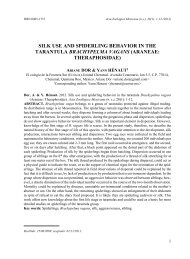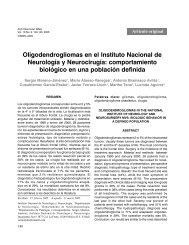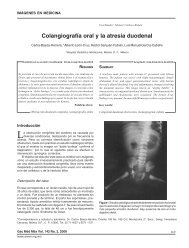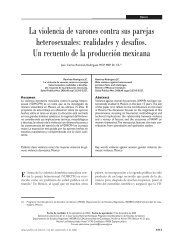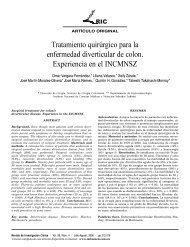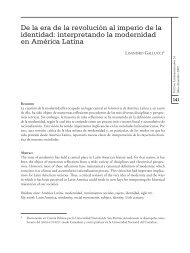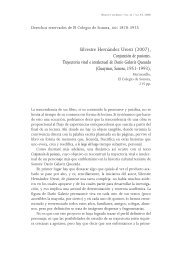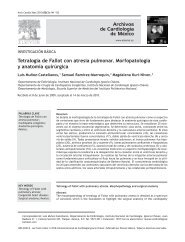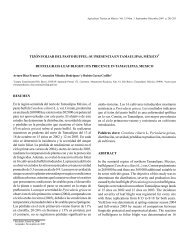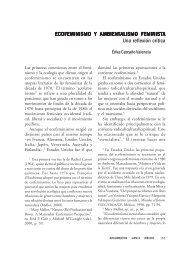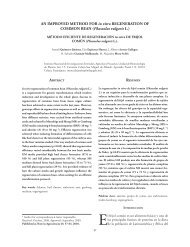RESISTENCIA A FUNGICIDAS EN POBLACIONES DE ... - SciELO
RESISTENCIA A FUNGICIDAS EN POBLACIONES DE ... - SciELO
RESISTENCIA A FUNGICIDAS EN POBLACIONES DE ... - SciELO
You also want an ePaper? Increase the reach of your titles
YUMPU automatically turns print PDFs into web optimized ePapers that Google loves.
<strong>RESIST<strong>EN</strong>CIA</strong> A <strong>FUNGICIDAS</strong> <strong>EN</strong> <strong>POBLACIONES</strong> <strong>DE</strong><br />
Mycosphaerella fijiensis <strong>DE</strong>L SURESTE MEXICANO<br />
FUNGICI<strong>DE</strong>S RESISTANCE ON Mycosphaerella fijiensis POPULATIONS<br />
OF SOUTHEASTERN MÉXICO<br />
Luciano Martínez-Bolaños 1 , Daniel Téliz-Ortiz 2 , J. Concepción Rodríguez-Maciel 2* , J. Antonio Mora-Aguilera 2 ,<br />
Daniel Nieto-Ángel 2 , J. Isabel Cortés-Flores 2 , Dimas Mejía-Sánchez 1 , Cristian Nava-Diaz 3 , Gonzalo Silva-Aguayo 3<br />
1 Universidad Autónoma Chapingo. 56230. Chapingo, Estado de México, México. 2 Fitopatología.<br />
Campus Montecillo. Colegio de Postgraduados. 56230. Montecillo, Estado de México.<br />
3 Universidad de Concepción, Facultad de Agronomía, Avenida Vicente Méndez 595, Casilla<br />
537, Chillán, Chile.<br />
Resumen<br />
El control de Sigatoka negra (Mycosphaerella fijiensis More-<br />
let) del banano (Musa acuminata Colla AAA) y plátano (Musa<br />
balbisiana Colla AAB) requiere de numerosas aplicaciones de<br />
fungicidas, principalmente de los grupos triazoles que indu-<br />
cen alta presión de selección en poblaciones del patógeno. El<br />
objetivo del presente estudio fue determinar la respuesta de<br />
cepas de M. fijiensis aisladas de plantaciones de banano de<br />
Tabasco y Chiapas, México, al propiconazol y tridemorf. Los<br />
bioensayos se realizaron en medio de cultivo Papa Dextro-<br />
sa Agar (PDA®) adicionados con diferentes concentraciones<br />
del fungicida. Los medios se inocularon con 100 mL de una<br />
suspensión conidial y fragmentos miceliares del hongo, y se<br />
incubaron en oscuridad a 26 °C por 7 d. La concentración<br />
efectiva 50 (CE 50 ) y 95 % (CE 95 ) para cada aislamiento se esti-<br />
mó mediante análisis Probit del porcentaje de inhibición del<br />
crecimiento relativo del patógeno. Los valores CE 50 en propi-<br />
conazol variaron de 0.0001 a 0.95 mg L -1 ; y los de CE 95 de<br />
0.006 a 12.51 mg L -1 . La proporción de resistencia en el nivel<br />
CE 95 fue superior a 2085×, para el aislamiento MF-RmC 2 de<br />
la finca Remedios en Teapa, Tabasco. Los valores para CE 50<br />
en tridemorf variaron de 0.00001 a 0.002 mg L -1 y los de<br />
CE 95 de 0.03 a 0.85 mg L -1 . La proporción de resistencia a<br />
nivel CE 95 entre el aislamiento sensible de referencia y el me-<br />
nos susceptible (MF-RcC 5 de la finca el Recreo, Tabasco) fue<br />
superior a 28.3×. La correlación positiva entre el número de<br />
aplicaciones y los valores de CE 50 y de CE 95 son indicativos de<br />
que la presión de selección ejercida en esta plantación generó<br />
resistencia al propiconazol.<br />
* Autor responsable v Author for correspondence.<br />
Recibido: junio, 2012. Aprobado: octubre, 2012.<br />
Publicado como ARTÍCULO en Agrociencia 46: 707-717. 2012.<br />
707<br />
AbstRAct<br />
The control of black Sigatoka (Mycosphaerella fijiensis) of<br />
banana (Musa acuminate Colla AAA) and (Musa balbisiana<br />
Colla AAB) requires numerous applications of fungicides,<br />
mainly of the triazoles group that impose high selection<br />
pressure in populations of this pathogen. The aim of the<br />
this study was to determine the response of strains of<br />
Mycosphaerella fijiensis isolated from banana plantations<br />
of Tabasco and Chiapas, México, to propiconazol and<br />
tridemorph. The bioassays were carried out in potato<br />
dextrose agar (PDA®) culture medium added with different<br />
concentrations of these fungicides. The media were inoculated<br />
with 100 mL of a conidial suspension and mycelia fragments<br />
of the fungus, and incubated in darkness at 26 °C for 7 d.<br />
The effective concentration 50 (EC 50 ) and 95 % (EC 95 ) was<br />
estimated through Probit analysis of the percentage of<br />
inhibition of the relative growth of the pathogen. The EC 50<br />
values in propiconazol varied from 0.0001 to 0.95 mg L -1<br />
and those of EC 95 from 0.006 to 12.51 mg L -1 . The resistance<br />
ratio at the level of EC 95 was higher than 2085×, for the isolate<br />
MF-RmC 2 of the Remedios plantation from Teapa, Tabasco.<br />
The values for EC 50 in tridemorph varied from 0.00001 to<br />
0.002 mg L -1 and those of EC 95 from 0.03 to 0.85 mg L -1 .<br />
The resistance ratio to level EC 95 between the sensitive isolate<br />
of reference and the least susceptible (MF-RcC 5 of the Recreo<br />
plantation, Tabasco) was higher than 28.3×. The positive<br />
correlation between the number of applications and the<br />
values of EC 50 and of EC 95 are indicative that the selection<br />
pressure exerted in this plantation generated resistance to the<br />
propiconazol.<br />
Key words: Black Sigota, propiconazol, tridemorph, banana,<br />
plantain.
AGROCI<strong>EN</strong>CIA, 1 de octubre - 15 de noviembre, 2012<br />
Palabras clave: Sigatoka negra, propiconazol, tridemorf, bana-<br />
no, plátano.<br />
708<br />
IntRoduccIón<br />
Mycosphaerella fijiensis Morelet (Anamorfo<br />
Pseudocercospora fijiensis) es el agente causal<br />
de la Sigatoka negra del banano (Musa<br />
acuminata Colla AAA) y plátano (Musa balbisiana<br />
Colla AAB) y es la principal enfermedad del banano<br />
(Churchill, 2011). El hongo causa lesiones foliares<br />
necróticas que se expanden y destruyen los tejidos,<br />
reduciendo la capacidad fotosintética, el volumen de<br />
producción e inducen la maduración del fruto (Stover,<br />
1974; Chillet et al., 2009). El control de Sigatoka<br />
negra se apoya en el manejo integrado del cultivo que<br />
considera mejorar el drenaje del suelo, baja densidad<br />
de siembra (2000 plantas ha -1 ), balance nutricional<br />
de N, P y K para inducir resistencia fisiológica, control<br />
de maleza, eliminación de tejido enfermo que<br />
actúa como fuente de inóculo y combate químico<br />
(Marín et al., 2003; Orozco et al., 2008; Kablan et<br />
al., 2012). La aspersión profiláctica o terapéutica de<br />
fungicidas de contacto o sistémicos es indispensable<br />
en el programa de manejo de esta enfermedad,<br />
pero aumenta el costo económico y riesgo ambiental<br />
(Chin et al., 2001), por lo cual se debe implementar<br />
un programa de manejo de la resistencia para reducir<br />
el número de aplicaciones. En México, los fungicidas<br />
más usados son mancozeb y clorotalonil (preventivos),<br />
e ingredientes sistémicos de los grupos benzimidazoles,<br />
triazoles, estrobirulinas, y anilopirimidinas<br />
(Romero y Sutton, 1997). En Tabasco, México,<br />
el manejo químico de la Sigatoka negra requiere 48<br />
a 52 aplicaciones de fungicidas por año, principalmente<br />
de mancozeb, propicona zol y tridemorf, por<br />
lo cual hay riesgo de desarrollo de resistencia del patógeno<br />
a estos agroquímicos (FRAC, 2010).<br />
La resistencia a fungicidas es un factor crítico que<br />
limita la eficiencia de los programas de manejo integrado<br />
del hongo, al incrementar dosis o frecuencias<br />
de aspersiones. Varios estudios muestran la capacidad<br />
de M. fijiensis para desarrollar resistencia a fungicidas<br />
sistémicos de los grupos benzimidazoles (Fullerton<br />
y Tracey, 1984; Romero y Sutton, 1998), triazoles<br />
(Romero y Sutton, 1997; Pérez, et al., 2003) y estrobirulinas<br />
(Sierotzki, et al., 2000; Marín et al., 2003).<br />
En contraste, no se ha documentado cambios significativos<br />
en la respuesta a morfolinas, a pesar de ser<br />
VOLUM<strong>EN</strong> 46, NÚMERO 7<br />
IntRoductIon<br />
Mycosphaerella fijiensis Morelet (Anamorfo<br />
Pseudocercospora fijiensis) is the causal<br />
agent of black Sigatoka of banana<br />
(Musa acuminate Colla AAA) and (Musa balbisiana<br />
Colla AAB) and is the principal disease of banana<br />
(Churchill, 2011). The fungus causes necrotic foliar<br />
lesions that expand and destroy the tissues, reducing<br />
the photosynthetic capacity, production volume and<br />
induces the maturation of the fruit (Stover, 1974;<br />
Chillet et al., 2009). The control of black Sigatoka<br />
is based on the integrated management of the crop<br />
which considers improving soil drainage, low crop<br />
density (2000 plants ha -1 ), nutritional balance of<br />
N, P and K for inducing physiological resistance,<br />
weed control, elimination of diseased tissue that<br />
acts as source of inoculum and chemical treatment<br />
(Marín et al., 2003; Orozco et al., 2008; Kablan et<br />
al., 2012). The prophylactic or therapeutic spraying<br />
of contact or systematic fungicides is indispensible<br />
in the management program of this disease, but it<br />
increases the economic cost and environmental risk<br />
(Chin et al., 2001), then, a resistance management<br />
program should be applied in order to reduce the<br />
number of applications. In México, the most widely<br />
used fungicides are mancozeb and chlorotalonyl<br />
(preventive), and systematic ingredients of the<br />
groups benzimidazoles, triazoles, estrobirulines<br />
and anilopirimidines (Romero and Sutton, 1997).<br />
In Tabasco, Mexico, the chemical management of<br />
black Sigatoka requires from 48 to 52 applications<br />
of fungicides per year, mainly of mancozeb,<br />
propiconazol and tridemorph; therefore, there is a<br />
risk of development of resistance of the pathogen to<br />
these agrochemicals (FRAC, 2010).<br />
Resistance to fungicides is a critical factor that<br />
limits the efficiency of the programs of integrated<br />
management of the fungus, when doses or frequencies<br />
of sprayings are increased. Several studies show,<br />
the capacity of M. fijiensis to develop resistance to<br />
systematic fungicides of the groups benzimidazoles<br />
(Fullerton and Tracey,1984; Romero and Sutton,<br />
1998), triazoles (Romero and Sutton, 1997; Pérez<br />
et al., 2003) and estrobirulines (Sierotzki et al.,<br />
2000; Marín et al., 2003). In contrast, no significant<br />
changes have been documented in the response to<br />
morfolines, even though it is a fungicide long used<br />
for controlling black Sigota in the main producing
un fungicida de uso antiguo para controlar Sigatoka<br />
negra en las principales zonas productoras de plátano<br />
y banano como Costa Rica y Ecuador. En México no<br />
hay estudios del grado de sensibilidad de M. fijiensis<br />
a los grupos toxicológicos de fungicidas (FRAC,<br />
2010). Por tanto, el objetivo de esta investigación fue<br />
determinar la respuesta a los fungicidas propiconazol<br />
y tridemorf en poblaciones de M. fijiensis que afectan<br />
al banano cv Gran Enano en Tabasco y Chiapas.<br />
mAteRIAles y métodos<br />
Aislamiento e identificación de los aislamientos<br />
El aislamiento de cepas de M. fijiensis se realizó del 2009 al<br />
2010 en plantaciones del cv. Gran Enano, Subgrupo Cavendish,<br />
en Tabasco y Chiapas, y los sitios de recolección tenían diferentes<br />
programas de manejo químico (Cuadro 1). Las cepas se aislaron<br />
en el laboratorio de enfermedades de frutales del programa de<br />
Fitopatología del Colegio de Posgraduados, Campus Monteci-<br />
llo, mediante el método de descarga de ascosporas (Stover, 1976)<br />
incubando secciones necróticas de tejidos foliar de 1.0 cm a<br />
26 °C/48 h en oscuridad. Los cultivos mono ascospóricos se ob-<br />
tuvieron en agua-agar al 3 % y se transfirieron a PDA (Bioxon TM )<br />
para favorecer la esporulación sexual (Romero y Sutton, 1997).<br />
Las ascosporas se incubaron cuatro semanas en cajas petri a<br />
26 °C en oscuridad para favorecer crecimiento miceliar y pro-<br />
ducción de conidios (Müller et al., 1997). Los aislamientos mono<br />
ascospóricos representativos se conservaron en tubos de ensayo<br />
con PDA a 4 °C.<br />
Caracterización cultural y molecular de aislamientos<br />
La verificación de la especie y caracterización morfológica de<br />
las ascosporas de aislamientos de M. fijiensis se realizó median-<br />
te las claves descritas por Hanlin (2000), Crous et al. (2007) y<br />
Arzanlou et al. (2008). Cada aislamiento mono ascospórico se<br />
incubó cuatro semanas a 26 °C. El ADN se extrajo del creci-<br />
miento miceliar con el método AP (Sambrook y Russell, 2001).<br />
La integridad del ADN se verificó por electroforesis mediante<br />
un gel de agarosa al 1 % a 80 V/40 min en amortiguador TBE<br />
teñido con bromuro de etidio. La identificación y confirmación<br />
de la especie se realizó con los iniciadores específicos MF137<br />
(5’-GGCGCCCCCGGAGGCCGTCTA-3’) (Johanson y Je-<br />
ger, 1993) y universal ITS4 (5’-TCCTCCGCTTATTGATAT-<br />
GC-3’) (White et al., 1990) para amplificar la región interna<br />
del transcrito (ITS) del rADN y producir fragmentos de 400 pb<br />
(Johanson y Jeger, 1993) en ocho aislamientos representativos.<br />
El proceso de PCR se desarrolló en un termociclador Mod 2720<br />
<strong>RESIST<strong>EN</strong>CIA</strong> A <strong>FUNGICIDAS</strong> <strong>EN</strong> <strong>POBLACIONES</strong> <strong>DE</strong> Mycosphaerella fijiensis <strong>DE</strong>L SURESTE MEXICANO<br />
zones of banana such as Costa Rica and Ecuador.<br />
In Mexico there are no studies of the degree of<br />
sensitivity of M. fijiensis to the toxicological groups<br />
of fungicides (FRAC, 2010). Therefore, the objective<br />
of the present study was to determine the response<br />
to the fungicides propiconazol and tridemorph in<br />
populations of M. fijiensis that affect banana cv Gran<br />
Enano in Tabasco and Chiapas.<br />
mAteRIAls And methods<br />
Isolation and identification of the isolates<br />
The isolation of strains of M. fijiensis was carried out from<br />
2009 to 2010 in plantations of cv. Gran Enano, Subgroup<br />
Cavendish, in Tabasco and Chiapas, and the collection sites<br />
had different chemical management programs (Table 1). The<br />
strains were isolated in the laboratories of fruit diseases of the<br />
Phytopathology Program of the Colegio de Postgraduados,<br />
Campus Montecillo, by means of the ascospore discharge<br />
method (Stover, 1976), incubating necrotic sections of foliar<br />
tissue of 1.0 cm at 26 °C/48 h in darkness. The mono ascosporic<br />
cultures were obtained in agar-agar at 3 % and were transferred<br />
to PDA (Bioxon TM ) to promote sexual sporulation (Romero and<br />
Sutton, 1997). The ascospores were incubated during four weeks<br />
in Petri dishes at 26 °C in darkness to speed mycelial growth and<br />
production of conidia (Müller et al., 1997). The representative<br />
mono ascosporic isolates were conserved in test tubes with PDA<br />
at 4 °C.<br />
Cultural and molecular characterization of isolates<br />
The verification of the species and morphological<br />
characterization of the ascospores of M. fijiensis isolates was made<br />
by means of the keys described by Hanlin (2000), Crous et al.<br />
(2007) and Arzanlou et al. (2008). Each mono ascosporic isolate<br />
was incubated during four weeks at 26 °C. The DNA was extracted<br />
from the mycelial growth with the AP method (Sambrook<br />
and Russell, 2001). The integrity of the DNA was verified by<br />
electrophoresis through an agarose gel at 1 % at 80 V/40 min in<br />
a TBE buffer stained with ethidium bromide. The identification<br />
and confirmation of the species was made with the specific<br />
primers MF137 (5’-GGCGCCCCCGGAGGCCGTCTA-3’)<br />
(Johanson and Jeger, 1993) and universal ITS4<br />
(5’-TCCTCCGCTTATTGATATGC-3’) (White et al., 1990)<br />
to amplify the internal transcribed region (ITR) of the rDNA<br />
and produce fragments of 400 pb (Johanson y Jeger, 1993) in<br />
eight representative isolates. The process of PCR was developed<br />
in a Mod 2720 thermocycler (Applied Biosystems®) and the<br />
MARTÍNEZ-BOLAÑOS et al.<br />
709
AGROCI<strong>EN</strong>CIA, 1 de octubre - 15 de noviembre, 2012<br />
Cuadro 1. Aislamiento de Mycosphaerella fijiensis en plantaciones de banano (Musa acuminata Colla AAA ‘Cultivar Gran<br />
Naime’) con diferente manejo químico en regiones productoras de Tabasco y Chiapas, México. Ciclo 2010-11.<br />
Table 1. Isolate of Mycosphaerella fijiensis in banana (Musa acuminate Colla AAA ‘Cultivar Gran Naime’) plantations with<br />
different chemical management in production regions of Tabasco and Chiapas, México. Cycle 2010-11.<br />
Aislamiento Finca Localidad Ubicación Grupos químicos y frecuencia<br />
geográfica de aspersión contra Sigatoka negra<br />
Cepa sensible CRUSE Puyacatengo, Teapa, N 17° 31’ 63.1” Plantas sin fungicidas.<br />
Tabasco O 92°55´84.2” Aisladas de zona bananera.<br />
MlC 13 Mulato Pichucalco, Chiapas. N 17° 41’ 88.2” 36 mancozeb<br />
O 93° 02’ 16.5”<br />
EbC 1 , EbC 4 , La Elba I. López Rayón, N 17° 38’ 63” 48 mancozeb; 2 triazol<br />
EbC 5 Teapa, Tabasco O 92° 57’ 58.7”<br />
JgC 1 , JgC 2 , JgC 3 Jaguar I. López Rayón, N 17° 37’ 94.1” 48 mancozeb; 2 estrobirulina; 1 triazol<br />
Teapa, Tabasco O 92° 58’ 61.7”<br />
Rc1C 3 , Rc1C 4 , Recreo I. López Rayón, N 17° 38’58.7” 28 mancozeb, 3 clorotalonil, 3 morfolinas;<br />
Rc1C 5 , Rc1C 6 Teapa, Tabasco O 92° 57’97.8” 3 benomilo 48 mancozeb<br />
RmC 1 , RmC 2 , Remedios J. Ma. Mor. y N 17° 37’ 2.7” 3 triazol<br />
RmC 4 , RmC 5 Pavón, Teapa, Tabasco O 92° 56’ 20.7”<br />
MrC 1 , MrC 2 , Miranda I. López Rayón, N 17º37’15.7” 48 mancozeb<br />
MrC 3 , MrC 4 Teapa, Tabasco O 92º57’70.7”<br />
AlgC 1 , AlgC 3 , R. Alegre Manuel Buelta, N 17°37´22.1” 39 mancozeb; 1 calixin;<br />
AlgC 4 , AlgC 5 Teapa, Tabasco O 92°57.780 1 trifloxistrobin; 4 benomilo<br />
Rita C4 R. Santa Rita I. López Rayón, N 17°37´22.1” 39 mancozeb; 1 calixin;<br />
Teapa, Tabasco O 92°57.780 1 trifloxistrobin; 4 benomilo<br />
(Applied Biosystems®) y la amplificación se desarrolló con 25 mL<br />
de una mezcla con 10 mM de cada iniciador, 10 mM dNTP, 10 x<br />
amortiguador de PCR, 50 mM MgCl2, 0.5 U Taq Polymerasa y<br />
0.5 ng de ADN molde. La rutina de PCR fue una desnaturaliza-<br />
ción inicial de un ciclo de 95° C/ 5 min, 35 ciclos a 95 °C/ 1 min,<br />
57° C/ 1 min y 72° C/ 1 min, con una extensión final de 72 °C/<br />
10 min. Los productos se separaron por electroforesis en gel de<br />
agarosa 1 % teñido con bromuro de etidio y visualizados en un<br />
transiluminador con luz UV. Se empleó un marcador molecular<br />
de 100 pb (Invitrogen®).<br />
710<br />
Concentración de fungicidas y efecto<br />
en el crecimiento micelial<br />
Los bioensayos se realizaron con dos fungicidas de uso co-<br />
mún para el manejo de Sigatoka negra: Tilt® 250 CE (Propicona-<br />
zol, concentrado emulsionable, 250 g de i.a. L -1. , Syngenta Agro<br />
S.A. de C.V.) y Calixin® CE (Tridemorf, concentrado emulsionable<br />
VOLUM<strong>EN</strong> 46, NÚMERO 7<br />
amplification was developed with 25 mL of a mixture with 10 mM<br />
of each primer, 10 mM dNTP, 10 x buffer of PCR, 50 mM<br />
MgC12, 0.5 U Taq Polymerase and 0.5 ng of mold DNA. The<br />
PCR routine was an initial denaturalization of a cycle of 95 °C/<br />
5 min, 35 cycles at 95 °C/ 1 min, 57 °C/ 1 min and 72 °C/<br />
1 min, with a final extension of 72 °C (10 min). The products<br />
were separated by electrophoresis in 1 % agarose gel stained with<br />
ethidium bromide and visualized in a transluminator with UV<br />
light. A molecular marker of 100 pb (Invitrogen®) was employed.<br />
Concentration of fungicides and effect in mycelial growth<br />
The bioassays were carried out with two fungicides of<br />
common use for the management of black Sigatoka: Tilt® 250<br />
CE (Propiconazol, emulsionable concentrate, 250 g of i.a. L -1 ,<br />
Syngenta Agro S.A. of C.V.) and Calixin® CE (Tridemorph,<br />
emulsionable concentrate 860 g of i.a. L -1 , Basf S.A. of C.V.).<br />
The fungicides were prepared in sterile distilled water in
860 g de i. a. L -1 , Basf S. A. de C.V.). Los fungicidas se prepara-<br />
ron en agua destilada estéril en concentraciones de 0.0 (testigo),<br />
0.000135, 0.00135, 0.0135, 0.135, 1.35, 13.5, y 135.00 mg i. a. mL -1 .<br />
Después se agregaron 10 mL de la concentración respectiva en<br />
190 mL de PDA y vaciaron en cajas petri. Cada tratamiento tuvo<br />
tres repeticiones y el experimento completo se repitió dos veces.<br />
El estudio se realizó con 200 cepas de M. fijiensis; 25 por<br />
finca bananera en ocho plantaciones en Tabasco y Chiapas. El<br />
inóculo de cada cepa individual se preparó de colonias de 15 d de<br />
edad en PDA (Bioxon). El crecimiento micelial de cada caja se<br />
raspó con una varilla de vidrio y se colocó en tubos de ensayo con<br />
10 mL de agua destilada estéril y 5 mL de Tween 20. La mezcla se<br />
homogeneizó con un agitador tipo vortex, se tomó una alícuota<br />
de 100 mL de la suspensión conidial y fragmentos miceliares y se<br />
dispersó con un asa bacteriológica sobre cajas petri con medio de<br />
cultivo PDA y se incubaron 7 d en oscuridad a 26 °C. Después,<br />
en cada concentración de fungicida se midió el diámetro (mm)<br />
de crecimiento micelial de 100 colonias formadas de fragmen-<br />
tos de micelio o conidios usando microfotografías y el programa<br />
Axiovision Carl Zeiss.<br />
Análisis estadístico<br />
El diseño experimental fue completamente al azar. La con-<br />
centración efectiva 95 % (CE 95 ), concentración efectiva 50 %<br />
(CE 50 ), límites de confianza (LC) y proporción de resistencia<br />
(PR) se determinó mediante el procedimiento Probit (SAS Ins-<br />
titute, 2003). La proporción de resistencia se obtuvo al dividir<br />
el valor de la CE 95 de cada cepa fungosa con la del aislamiento<br />
sensible de M. fijiensis. La respuesta fue significativamente dife-<br />
rente cuando los LC al 95 % no exhibieron traslape (Robertson<br />
y Preisler, 1992). La correlación entre la CE 95 y frecuencia de<br />
aplicaciones en campo de fungicidas sistémicos (Cuadro 1) para<br />
el manejo de Sigatoka negra se determinó usando el coeficiente<br />
de Pearson (SAS Institute, 2003).<br />
ResultAdos y dIscusIón<br />
Aislamiento e identificación de aislamientos<br />
Todos los aislamientos mono ascospóricos obtenidos<br />
por descargas de ascosporas a partir de de tejidos<br />
de hojas de banano con Sigatoka negra se identificaron<br />
como M. fijiensis. Las ascosporas fueron de coloración<br />
hialina, forma globosa y con un septo que<br />
forman dos células unidas, una de las cuales siempre<br />
fue ligeramente más abultada que la otra. El micelio<br />
fue de color blanco y apariencia algodonosa, redonda<br />
y de creci miento lento. El reverso de la caja petri<br />
mostró un color negro con bordes blancos.<br />
<strong>RESIST<strong>EN</strong>CIA</strong> A <strong>FUNGICIDAS</strong> <strong>EN</strong> <strong>POBLACIONES</strong> <strong>DE</strong> Mycosphaerella fijiensis <strong>DE</strong>L SURESTE MEXICANO<br />
concentrations of 0.0 (control), 0.000135, 0.00135, 0.0135,<br />
0.135, 1.35, 13.5 and 135.00 mg i.a. mL -1 . Then, 10 mL of<br />
the respective concentration was added in 190 mL of PDA and<br />
emptied into Petri dishes. Each treatment had three replicates<br />
and the complete experiment was repeated twice.<br />
The study was carried out with 200 strains of M. fijiensis,<br />
25 per banana plantation in eight plantations in Tabasco and<br />
Chiapas. The inoculum of each individual strain was prepared in<br />
colonies of 15 d of age in PDA (Bioxon). The mycelial growth<br />
of each dish was scraped with a glass rod and placed in test tubes<br />
with 10 mL of sterile distilled water and 5 mL of Tween 20. The<br />
mixture was homogenized with a vortex type agitator, an aliquot<br />
of 100 mL of the conidial suspension and mycelia fragments<br />
was taken and dispersed with a bacteriological handle over<br />
Petri dishes with PDA culture medium and were incubated<br />
for 7 d in darkness at 26 °C. Later on, in each concentration<br />
of fungicide, the diameter (mm) of mycelial growth was<br />
measured of 100 colonies formed from fragments of mycelia or<br />
conidia using microphotographs and the program Axiovision<br />
Carl Zeiss.<br />
Statistical analysis<br />
The experimental design was completely randomized. The<br />
effective concentration 95 % (EC 95 ), effective concentration<br />
50 % (EC 50 ), confidence limits (CL) and resistance ratio (RR)<br />
were determined by means of the Probit procedure (SAS Institute,<br />
2003). The resistance ratio was obtained by dividing the value of<br />
the EC 95 of each fungous strain with that of the sensitive isolate<br />
of M. fijiensis. The response was significantly different when the<br />
CL at 95 % did not overlapped (Robertson and Preisler, 1992).<br />
The correlation between the EC 95 and the frequency of field<br />
applications of systematic fungicides (according to Table 1) for<br />
the management of black Sigatoka was determined using the<br />
Pearson coefficient (SAS Institute, 2003).<br />
Results And dIscussIon<br />
Isolation and identification of isolates<br />
All of the mono ascosporic isolates obtained by<br />
discharges of ascospores from tissues of banana leaves<br />
with black Sigatoka were identified as M. fijiensis.<br />
The ascospores were hyaline colored, round shaped<br />
and with a septum formed by two united cells, one of<br />
which was always slightly more bulky than the other.<br />
The mycelium was white in color and of a cotton-like<br />
appearance, round and of slow growth. The reverse<br />
of the Petri dish displayed a black color with white<br />
edges.<br />
MARTÍNEZ-BOLAÑOS et al.<br />
711
AGROCI<strong>EN</strong>CIA, 1 de octubre - 15 de noviembre, 2012<br />
712<br />
Caracterización molecular de aislamientos<br />
La amplificación y secuenciación de la región ITS<br />
(Figura 1) del gen rADN de aislamientos representativos<br />
presentaron 100 % de similitud a la secuencia<br />
documentada por Johanson y Jeger (1993) para M.<br />
fijiensis.<br />
Efecto del propiconazol y tridemorf en el<br />
crecimiento de M. fijiensis<br />
Respuesta al propiconazol<br />
La concentración efectiva 50 % (CE 50 ) que presentó<br />
M. fijiensis a propiconazol fue de 0.0001 a<br />
0.095 mg L -1 y la CE 95 de 0.006 a 12.51 mg L -1 .<br />
Los aislamientos de la finca Remedios de Tabasco<br />
tuvieron la mayor CE 95 , con valores de 9.49 a 12.51<br />
mg L -1 . Los aislamientos con mayor sensibilidad se<br />
presentaron en las fincas sin aplicación del fungicida<br />
(Cuadro 2). No hubo superposición de los LC a 95<br />
% de mortalidad, por lo cual se consideraron significativamente<br />
diferentes los aislamientos de M. fijiensis<br />
respecto al aislamiento sensible. La mayor proporción<br />
de resistencia (PR) a nivel de CE 95 se observó en el<br />
aislamiento MF-AlgC 3 (> 2085×) (Cuadro 2). Estos<br />
1 2 3 4 5 6 7 8 9 M<br />
Figura 1. Verificación taxonómica de ocho aislamientos de Mycosphaerella fijiensis por amplificación del producto PCR de<br />
aproximadamente 400 pb, con iniciadores ITS4-MF137, donde: columna 1 (MF-RmC4), 2 (testigo negativo), 3 (MF-<br />
RmC2), 4 (MF-AlgC5), 5 (MF-EbC1), 6 (MF-AlgC4), 7 (MF-AlgC5), 8 (MF-JgC1), 9 (MF-MrC1) y 10 (marcador<br />
molecular de 100 pb, Invitrogen®).<br />
Figure 1. Taxonomic verification of eight isolates of Mycosphaerella fijiensis by amplification of the PCR product of approximately<br />
400 pb, with primers ITS4-MF137, where: column 1 (MF-RmC4), 2 (negative control), 3 (MF-RmC2), 4 (MF-AlgC5),<br />
5 (MF-EbC1), 6 (MF-AlgC4), 7 (MF-AlgC5), 8 (MF-JgC1), 9 (MF-MrC1) and 10 (molecular marker of 100 pb,<br />
Invitrogen®).<br />
VOLUM<strong>EN</strong> 46, NÚMERO 7<br />
Molecular characterization of isolates<br />
The amplification and sequencing of ITS region<br />
(Figure 1) of the gene rDNA of representative<br />
isolates presented 100 % similarity to the sequence<br />
documented by Johanson and Jeger (1993) for M.<br />
fijiensis.<br />
Effect of propiconazol and tridemorph<br />
on the growth of M. fijiensis<br />
Response to propiconazol<br />
The effective concentration 50 % (EC 50 )<br />
presented by M. fijiensis to propiconazol was 0.0001<br />
to 0.095 mg L -1 and the EC 95 of 0.006 to 12.51 mg<br />
L -1 . The isolates of the Remedios plantation of<br />
Tabasco had the highest EC 95 , with values of 9.49 to<br />
12.51 mg L -1 . The isolates with highest sensitivity<br />
appeared in the plantations without the application<br />
of the fungicide (Table 2). There was no overlapping of<br />
the CL to 95 % of mortality, thus the isolates of M.<br />
fijiensis were considered significantly different with<br />
respect to the sensitive isolate. The highest resistance<br />
ratio (RR) at the level EC 95 was observed in the<br />
isolate MF-AlgC 3 (> 2085×) (Table 2). These results<br />
400 pb
<strong>RESIST<strong>EN</strong>CIA</strong> A <strong>FUNGICIDAS</strong> <strong>EN</strong> <strong>POBLACIONES</strong> <strong>DE</strong> Mycosphaerella fijiensis <strong>DE</strong>L SURESTE MEXICANO<br />
Cuadro 2. Sensibilidad al fungicida propiconazol de aislamientos de M. fijiensis recolectados en fincas bananeras de Tabasco y<br />
Chiapas con diferentes programas de control. Ciclo 2010-2011.<br />
Table 2. Sensitivity to the fungicide propiconazol of isolates of M. fijiensis collected in banana plantations of Tabasco and<br />
Chiapas with different control programs. Cycle 2010-2011.<br />
Aislamiento b±EE CE 50 (mg ml -1 ) CE 95(mg ml -1 ) p > c 2 * PR 50 PR 95<br />
MF-EbC1 1.78 ± 0.15 0.0015 (0.0012 - 0.0021) 0.56 (0.21 - 2.15) 0.0001 15 93.33<br />
MF-EbC4 3.12 ± 0.27 0.0014 (0.0009 - 0.002) 0.044 (0.025 - 0.096) 0.0001 14 7.33<br />
MF-EbC5 3.28 ± 0.29 0.0063 (0.005 - 0.008) 0.079 (0.051 - 0.145) 0.0001 63 13.17<br />
MF-JgC1 3.46 ± 0.31 0.001 (0.0008 - 0.0015) 0.028 (0.017 - 0.060) 0.0001 110 4.67<br />
MF-JgC2 4.09 ± 0.53 0.0001(0.00003 - 0.0001) 0.0034 (0.002 - 0.010) 0.0001 1.0 0.6<br />
MF-RcC3 1.60 ± 0.18 0.005(0.0032 - 0.0081) 0.116 (0.424 - 0.49) 0.0001 50 193.33<br />
MF-RcC4 4.21 ± 0.41 0.0016(0.0012 - 0.002) 0.0198 (0.0122 - 0.0384) 0.0001 16 3.30<br />
MF-RcC5 5.17 ± 0.51 0.0005 (0.0004 - 0.0007) 0.0058 (0.004 - 0.011) 0.0001 5 0.97<br />
MF-RmC1 1.54 ± 0.18 0.0012 (0.006 - 0.002) 10.53 (4.17 - 21.98) 0.0001 12 1755<br />
MF-RmC2 0.35 ± 0.09 0.051 (0.035 - 0.070) 12.51 (7.01 - 28.89) 0.0001 510 2085<br />
MF-RmC4 0.88 ± 0.09 0.07 (0.02 - 0.14) 9.49 (4.20 - 20.61) 0.0001 700 1581.7<br />
MF-RmC5 0.3 ± 0.09 0.095 (0.07 - 0.13) 10.20 (6.51 - 18.87) 0.0001 950 1700<br />
MF-AlgC1 2.03 ± 0.20 0.006 (0.004 - 0.009) 0.38 (0.18 - 0.99) 0.0001 61 63<br />
MF-AlgC3 5.02 ± 0.48 0.0012 (0.0009 - 0.0015) 0.010 (0.007 - 0.019) 0.0001 12 1.67<br />
MF-AlgC4 2.84 ± 0.28 0.0126 (0.0095 - 0.0167) 0.158 (0.097 - 0.306) 0.0001 126 26.33<br />
MF-AlgC5 2.13 ± 0.20 0.0037 (0.0025 - 0.0054) 0.2786 (0.1344 - 0.75) 0.0001 37 46.43<br />
MF-MrC1 3.39 ± 0.41 0.0001 (0.00008 - 0.0003) 0.011 (0.005 - 0.037) 0.0001 1 1.83<br />
MF-MrC2 4.39 ± 0.43 0.0009 (0.0006 - 0.0012) 0.012 (0.008 - 0.024) 0.0001 9 2.0<br />
MF-MrC3 3.41 ± 0.41 0.0002 (0.00008 - 0.0003) 0.011 (0.005 - 0.036) 0.0001 2 1.83<br />
MF-MrC4 1.99 ± 0.20 0.0008 (0.0004 - 0.001) 0.284 (0.107 - 1.196) 0.0001 8 47.33<br />
MF-RtaC4 4.28 ± 0.41 0.0015 (0.0012 - 0.0021) 0.185 (0.115 - 0.357) 0.0001 15 30.83<br />
Susceptible 3.62 ± 0.55 0.0001 (0.0006 - 0.001) 0.006 (0.0004 - 0.01) 0.0001<br />
b = valor de la pendiente; = Error estándar de la pendiente; * = Probabilidad de que la línea log Dosis-Probit ajuste a una línea recta v<br />
b=value of the slope; =Standard error of the slope; *Probability that the line log Dosis-Probit fits to a straight line.<br />
resultados coincidieron con los de Romero y Sutton<br />
(1997) quienes caracterizaron la sensibilidad de M.<br />
fijiensis a propiconazol en Costa Rica, con valores<br />
de CE 50 entre 0.06 y 0.05 mg L -1 para poblaciones<br />
con historial de aplicaciones de propiconazol y 0.008<br />
mg L -1 en susceptibles, con un PR 50 de 6.0× y 7.5×.<br />
De acuerdo con estos valores, sólo los aislamientos<br />
de M. fijiensis de la finca Remedios (Teapa, Tabasco),<br />
donde se aplicaron tres ciclos de fungicidas por año,<br />
pueden considerarse como resistentes a propiconazol<br />
mientras que en los restantes, donde se usa mayoritariamente<br />
mancozeb (Cuadro 1) son sensibles. Según<br />
Pérez et al. (2003), los niveles de sensibilidad a triazoles,<br />
como propiconazol, de poblaciones de M. fijiensis<br />
están en un CE 50 de 0.0001 a 0.001 mg L -1 , aunque<br />
la sensibilidad (CE 50 ) disminuye en el tiempo entre<br />
0.03 a 0.1 mg L -1 con una correlación lineal entre la<br />
pérdida de sensibilidad y el número de aplicaciones<br />
de triazoles. En 42 cepas de M. fijiensis provenientes<br />
de Ecuador, Brasil, Costa Rica, África y sudeste de Asia<br />
hubo una gran variabilidad en la sensibilidad a triazoles,<br />
coincide with those of Romero and Sutton (1997),<br />
who characterized the sensitivity of M. fijiensis to<br />
propiconazol in Costa Rica, with values of EC 50<br />
between 0.06 and 0.05 mg L -1 for populations with<br />
a history of applications of propiconazol and 0.008<br />
mg L -1 in susceptible populations, with an RP 50 of<br />
6.0× and 7.5×. According to these values, only the<br />
isolates of M. fijiensis of the Remedios plantation<br />
(Teapa, Tabasco), where three cycles of fungicide<br />
were applied per year, can be considered resistant to<br />
propiconazol, whereas in the rest, where mancozeb is<br />
mostly used (Table 1), they are sensitive. According to<br />
Pérez et al. (2003), the level of sensitivity to triazoles,<br />
such as propiconazol, of populations of M. fijiensis<br />
are in an EC 50 of 0.0001 to 0.001 mg L -1 , although<br />
the sensitivity (EC 50 ) diminishes in the time between<br />
0.03 to 0.1 mg L -1 with a linear correlation between<br />
the loss of sensitivity and the number of applications<br />
of triazoles. In 42 strains of M. fijiensis from Ecuador,<br />
Brasil, Costa Rica, Africa and Southeast Asia, there<br />
was great variability in the sensitivity to triazoles,<br />
MARTÍNEZ-BOLAÑOS et al.<br />
713
AGROCI<strong>EN</strong>CIA, 1 de octubre - 15 de noviembre, 2012<br />
Cuadro 3. Sensibilidad al fungicida tridemorf de aislamientos de M. fijiensis recolectados en fincas bananeras de Tabasco y<br />
Chiapas con diferentes programas de control. Ciclo 2010-2011.<br />
Table 3. Sensitivity to the fungicide tridemorph of isolates of M. fijiensis collected in banana plantations of Tabasco and Chiapas<br />
with different control programs. Cycle 2010-2011.<br />
Aislamiento b±EE CE 50 (mg ml -1 ) CE 95(mg ml -1 ) p > c 2 * PR 50 PR 95<br />
MF-EbC4 2.2 ± 0.2 0.0004 (0.0002 - 0.0006) 0.133 (0.053 - 0.46) 0.0001 4.0 4.43<br />
MF-EbC5 1.9 ± 0.2 0.0001 (0.00007 - 0.0002) 0.301 (0.09 - 0.1.78) 0.0001 1.0 10.03<br />
MF-JgC1 1.9 ± 0.2 0.00006 (0.000001 - 0.00001) 0.14 (0.03 - 1.74) 0.0001 0.1 4.67<br />
MF-JgC2 1.7 ± 0.2 0.002 (0.0015 - 0.004) 0.33 (0.29 - 0.64) 0.0001 20 11.0<br />
MF-RcC3 2.2 ± 0.2 0.0017 (0.001 - 0.003) 0.85 (0.80 - 0.90) 0.0001 17 28.3<br />
MF-RcC4 1.2 ± 0.1 0.00002 (0.000006 - 0.00007) 0.72 (0.05 - 1.78) 0.0001 0.2 24.0<br />
MF-RcC5 1.3 ± 0.1 0.00002 (0.0000007 - 0.00005) 0.20 (0.16 - 0.45) 0.0001 0.2 21.0<br />
MF-RmC1 1.7 ± 0.2 0.00002 (0.000007 - 0.00005) 0.07 (0.017 - 0.51) 0.0001 0.2 2.3<br />
MF-RmC2 1.8 ± 0.2 0.00007 (0.00004 - 0.0001) 0.35 (0.09 - 0.64) 0.0001 0.7 11.7<br />
MF-RmC4 1.9 ± 0.1 0.0002 (0.0001 - 0.0003) 0.35 (0.13 - 0.73) 0.0001 2 11.7<br />
MF-RmC5 1.8 ± 0.2 0.0001 (0.00006 - 0.0002) 0.47 (0.12 - 0.95) 0.0001 1 15.7<br />
MF-AlgC4 3.2 ± 0.3 0.0005 (0.0003 - 0.0008) 0.08 (0.04 - 0.16) 0.0001 5.0 2.7<br />
MF-AlgC5 1.7 ± 0.2 0.0002 (0.0001 - 0.0004) 0.61 (0.16 - 1.12) 0.0001 2.0 20.3<br />
MF-MrC1 2.0 ± 0.2 0.0015 (0.001 - 0.002 0.30 (0.12 - 0.80) 0.0001 15 10.0<br />
MF-MrC2 1.9 ± 0.2 0.0009 (0.0005 - 0.001) 0.36 (0.13 - 0.74) 0.0001 9 12.0<br />
MF-MrC3 1.9 ± 0.2 0.0001 (0.00006 - 0.0002) 0.36 (0.10 - 0.62) 0.0001 1 12.0<br />
Susceptible 3.8 ± 0.3 0.0001 (0.0001 - 0.0002) 0.006 (0.003 - 0.015) 0.0001 1.0<br />
b = valor de la pendiente; = Error estándar de la pendiente; * = Probabilidad de que la línea log Dosis-Probit ajuste a una línea recta v<br />
b=value of the slope; =Standard error of the slope; *Probability that the line log Dosis-Probit fits to a straight line.<br />
con CE 50 £0.095 mg L -1 para poblaciones sensibles,<br />
y 0.18 - 0.39 y ³0.90 mg L -1 para tolerantes y resistentes<br />
(Cañas et al. 2009). Las cepas resistentes<br />
se identificaron en países donde se realiza un alto<br />
Figura 2. Relación entre el número de aplicaciones de fungicidas contra Sigatoka negra y la concentración efectiva necesaria<br />
para reducir el crecimiento miceliar al 95 % (CE 95 ) para 23 aislamien tos seleccionados de Mycosphaerella fijiensis. A)<br />
propiconazol, B) tridemorf. r es el valor de la correlación Pearson Prob > |r| suponiendo Ho: Rho=0.<br />
Figure 2. Relationship between the number of applications of fungicides against black Sigatoka, and the effective concentration<br />
necessary for reducing the mycelial growth by 95 % (EC 95 ) for 23 selected isolates of Mycosphaerella fijiensis. A)<br />
propiconazol, B) tridemorph, r is the value of the Pearson Prob correlation > |r| assuming Ho: Rho=0.<br />
714<br />
14<br />
12<br />
10<br />
8<br />
6<br />
4<br />
2<br />
0<br />
r=0.81<br />
p£0.0001<br />
0 1 2 3<br />
Número de aplicaciones de propiconazol por año<br />
VOLUM<strong>EN</strong> 46, NÚMERO 7<br />
4<br />
with EC 50 £0.095 mg L -1 for sensitive populations,<br />
and 0.18-0.39 and ³0.90 mg L -1 for tolerant and<br />
resistant populations (Cañas et al., 2009). The<br />
resistant strains were identified in countries where a<br />
0.9<br />
0.8<br />
0.7<br />
0.6<br />
0.5<br />
0.4<br />
0.3<br />
0.2<br />
0.1<br />
r=0.81<br />
p£0.0001<br />
0<br />
0 1 2 3 4<br />
Número de aplicaciones de propiconazol por año
número de aplicaciones de fungicidas por ciclo como<br />
Ecuador y Costa Rica (Marín et al., 2003).<br />
Respuesta al tridemorf.<br />
Los valores de la CE 50 para los aislamientos de<br />
M. fijiensis fluctuaron entre 0.0001 mg L -1 y 0.002<br />
mg L -1 y la CE 95 entre 0.006 mg L -1 y 2.0 mg L -1 .<br />
Los aislamientos de la finca Recreo (MF-RcC 3, MF-<br />
RcC 4, MF-RcC 5 ) y Alegre (MF-AlgC5) presentaron<br />
la mayor CE 95 . Al no registrarse superposición de<br />
los límites de confianza a un 95 % de mortalidad, se<br />
consideró que existe diferencia estadística entre los<br />
aislamientos de M. fijiensis y el sensible. La PR a nivel<br />
CE 95 entre el aisla miento sensible y el más tolerante<br />
fue superior a 28.3×, y correspondió al aislamiento<br />
MF-RcC 3 (Cuadro 3).<br />
Correlación entre variables<br />
La correlación entre el número de aplicaciones de<br />
propiconazol en campo y el nivel de sensibilidad CE 95<br />
de los aislamientos de M. fijiensis fue significativa<br />
(r=0.8; p£0.0001). La correlación con el número de<br />
aplicaciones y los valores de proporción de resistencia<br />
a nivel de CE 50 y de CE 95 indican que los aislamientos<br />
de M. fijiensis de la plantación Remedios son resistentes<br />
al propiconazol (Figura 2A). La sensibilidad<br />
del hongo al propiconazol muestra una correlación<br />
lineal entre la pérdida de sensibilidad y el número de<br />
aplicaciones de triazoles (Pérez et al., 2003; Cañas et<br />
al. 2009), y en M. graminicola hay una correlación<br />
significativa entre las variaciones genéticas del patógeno<br />
y la presión de selección a fungicidas (Ware et<br />
al., 2006). Según Cañas et al. (2009) y Mullins et al.<br />
(2011), la resistencia de M. fijiensis a propiconazol y<br />
fungicidas inhibidores de la desmetilación (DMIs) se<br />
correlaciona con uno o más sitios de mutación de la<br />
secuencia del gen CYP51 (Y136F, A313G, Y461D,<br />
Y463H, Y463N y Y463S) que codifica a la enzima<br />
esterol 14 a-demethylasa, esencial en la biosíntesis<br />
del ergosterol el cual afecta la fluidez y permeabilidad<br />
de las células del hongo que es esencial para la sobrevivencia<br />
de la célula (Lepesheva y Waterman, 2004).<br />
Respecto a la CE 95 para tridemorf, los aislamientos<br />
mostraron amplia variación en susceptibilidad. Entre<br />
el grado sensibilidad del hongo (CE 95 ) y el número de<br />
aplicaciones de esta molécula realizadas para el control<br />
de M. fijiensis hubo una correlación positiva (r=0.82)<br />
<strong>RESIST<strong>EN</strong>CIA</strong> A <strong>FUNGICIDAS</strong> <strong>EN</strong> <strong>POBLACIONES</strong> <strong>DE</strong> Mycosphaerella fijiensis <strong>DE</strong>L SURESTE MEXICANO<br />
high number of applications of fungicides are made<br />
per cycle such as Ecuador and Costa Rica (Marín et<br />
al., 2003).<br />
Response to tridemorph.<br />
The values of the EC 50 for the isolates of M.<br />
fijiensis fluctuated between 0.0001 mg L -1 and 0.002<br />
mg L -1 and the EC 95 between 0.006 mg L -1 and<br />
2.0 mg L -1 . The isolates of the Recreo (MF-RcC 3 ,<br />
MF-RcC 4 , MF-RcC 5 ) and Alegre (MF-AlgC5)<br />
plantations presented the highest EC 95 . As there<br />
was no overlapping of the confidence limits at 95 %<br />
mortality, it was considered that there is a statistical<br />
difference between the isolates of M. fijiensis and<br />
the sensitive one. The RP at level EC 95 between the<br />
sensitive isolate and the most tolerant was higher<br />
than 28.3×, and corresponded to the isolate MF-<br />
RcC 3 (Table 3).<br />
Correlation between variables<br />
The correlation between the number of<br />
applications of propiconazol in the field and the<br />
sensitivity level EC 95 of the isolates of M. fijiensis<br />
was significant (r=0.8; p£0.0001). The correlation<br />
with the number of applications and the values<br />
of proportion of resistance to level EC 50 and EC 95<br />
indicate that the isolates of M. fijiensis of the<br />
Remedios plantation are resistant to propiconazol<br />
(Figure 2A). The sensitivity of the fungus to the<br />
propiconazol shows a linear correlation between the<br />
loss of sensitivity and the number of applications of<br />
triazoles (Pérez et al., 2003; Cañas et al., 2009), and<br />
in M. graminicola there is a significant correlation<br />
between the genetic variations of the pathogen and the<br />
selection pressure on fungicides (Ware et al., 2006).<br />
According to Cañas et al. (2009) and Mullins et al.<br />
(2011), the resistance of M. fijiensis to propiconazol<br />
and demethylation inhibiting fungicides is correlated<br />
to one or more mutation sites of the gene sequence<br />
CYP51 (Y136F, A313G, Y461D, Y463H, Y463N<br />
and Y463S) which codifies the enzyme sterol 14<br />
a-demethylasa, essential in the biosynthesis of the<br />
ergosterol, which affects the fluidity and permeability<br />
of the cells of the fungus, which is essential for the<br />
survival of the cell (Lepesheva and Waterman, 2004).<br />
With respect to the EC 95 , for tridemorph, the isolates<br />
showed wide variation in susceptibility. Between the<br />
MARTÍNEZ-BOLAÑOS et al.<br />
715
AGROCI<strong>EN</strong>CIA, 1 de octubre - 15 de noviembre, 2012<br />
(Figura 2B). Tridemorf es un fungicida del grupo de<br />
las morfolinas con actividad protectante y sistémica<br />
que inhibe la síntesis de ergosterol de tipo II sobre<br />
la Δ7-Δ 8 iomerasa y la C 14 reductasa (Kerkenaar,<br />
1995). No hay cambios significativos de resistencia<br />
de M. fijiensis a morfolinas, ya que son fungicidas de<br />
bajo riesgo de desarrollo de resistencia; además, su<br />
movimiento en musáceas es limitado, esencialmente<br />
traslaminar (Cronshaw et al. 1994). FRAC (2010)<br />
indica que tridemorf es un componente importante<br />
en las estrategias anti resistencia a benzimidazoles, estrobirulinas<br />
y triazoles.<br />
El desarrollo de resistencia a fungicidas en poblaciones<br />
de M. fijiensis puede estar influenciado por factores<br />
genéticos, bioecológicos y operacionales como<br />
frecuencia inicial de alelos de resistencia, número y<br />
expresividad de los genes, duración de la generación,<br />
tasa epidémica de reproducción y uso de fungicidas.<br />
En este sentido, cuando se detecta resistencia del patógeno<br />
a un fungicida específico, dependiendo de su<br />
grado y estabilidad, éste debe restringirse o detener su<br />
uso por varios ciclos de cultivo y usar un fungicida alterno<br />
con diferente modo de acción y mecanismos de<br />
destoxificación (FRAC, 2010). Un programa fitosanitario<br />
exitoso apoyado en los fungicidas inhibidores<br />
de la dimetilación, estará en función de mantener un<br />
nivel bajo de la fuente de inóculo mediante prácticas<br />
culturales (Orozco et. al., 2008).<br />
716<br />
conclusIones<br />
La correlación entre el número de aplicaciones y<br />
los valores de proporción de resistencia tanto a nivel<br />
de CE 50 como de CE 95 indicaron que los aislamientos<br />
de M. fijiensis de la plantación Remedios en Teapa,<br />
Tabasco, fueron resistentes al propiconazol; sin<br />
embargo, los demás aislamientos fueron susceptibles.<br />
Todos los aislamientos del hongo fueron susceptibles<br />
al tridemorf. Hubo una correlación significativa entre<br />
el número de aplicaciones en campo y el nivel de<br />
resistencia al propiconazol.<br />
AgRAdecImIentos<br />
A los productores de plátano y banano de México,<br />
y al CONACYT (FOR<strong>DE</strong>CYT No.116886) por el<br />
apoyo económico brindado para el desarrollo del presente<br />
trabajo de investigación. Se agradece el apoyo de<br />
la Línea Prioritaria de Investigación No. 7: Inocuidad,<br />
VOLUM<strong>EN</strong> 46, NÚMERO 7<br />
degree of sensitivity of the fungus (EC 95 ) and the<br />
number of applications of this molecule carried out<br />
for the control of M. fijiensis, there was a positive<br />
correlation (r=0.82) (Figure 2B). Tridemorph is a<br />
fungicide of the group of morpholines with protective<br />
and systematic activity that inhibits the synthesis<br />
of type II ergosterol over the Δ7-Δ 8 iomerase and<br />
the C 14 reductase (Kerkenaar, 1995). There are no<br />
significant changes of resistance of M. fijiensis to<br />
morfolinas, given that they are fungicides of low risk<br />
of developing resistance; furthermore, its movement<br />
in Musacea is limited, essentially to translaminate<br />
(Cronshaw et al., 1994). FRAC (2010) indicates that<br />
tridemorph is an important component in the antiresistance<br />
strategies to benzimidazoles, estrobirulinas<br />
and triazoles.<br />
The development of resistance to fungicides<br />
in populations of M. fijiensis may be influenced<br />
by genetic, bioecological and operational factors<br />
such as initial frequency of alleles of resistance,<br />
number and expressivity of the genes, duration of<br />
the generation, epidemic rate of reproduction and<br />
use of fungicides. In this sense, when resistance to<br />
the pathogen to a specific fungicide is detected,<br />
depending on its degree and stability, this should be<br />
restricted or its use detained for various crop cycles<br />
and uses an alternative fungicide with different<br />
degree of action and detoxification mechanisms<br />
(FRAC, 2010). A successful phytosanitary program<br />
based on demethylation inhibiting fungicides will be<br />
a function of maintaining a low level of the source of<br />
inoculum through cultural practices (Orozco et al.,<br />
2008).<br />
conclusIons<br />
The correlation between the number of<br />
applications and the values of resistance ratio, both at<br />
the level of EC 50 and of EC 95 indicated that the isolates<br />
of M. fijiensis of the Remedios plantation in Teapa,<br />
Tabasco, were resistant to propiconazol; however, the<br />
other isolates were susceptible. All of the isolates of<br />
the fungus were susceptible to the tridemorph. There<br />
was a significant correlation between the number of<br />
applications in the field and the level of resistance to<br />
the propiconazol.<br />
pppvPPP<br />
—End of the English version—
calidad alimentaria y bioseguridad, del Colegio de<br />
Postgraduados.<br />
lIteRAtuRA cItAdA<br />
Arzanlou, M., J. Z. Groenewald, R. A. Ullerton, E. C. A. Abel,<br />
J. Carlier, M. F. Zapater, A. Buddenhagen, and P. W. Crous.<br />
2008. Multiple gene genealogies and phenotypic characters<br />
differentiate several novel species of Mycosphaerella and related<br />
anamorphos on ba nana. Persoonia 20: 19-37.<br />
Cañas, G. G. P., V. M. J. Angarita, F. J. M. Restrepo, P. Rodríguez,<br />
C. X. Moreno, and R. Arango. 2009. Analysis of<br />
the CYP51 gene encoded protein in propiconazole resistant<br />
isolates of Mycosphaerella fijiensis. Pest Manage. Sci. 65: 892-<br />
899.<br />
Chillet, M., C. Abadie, O. Hubert, Y. Ch. Chilin, and D. B. L.<br />
De Lapeyre. 2009. Sigatoka disease reduces the greenlife of<br />
bananas. Crop Protect. 28: 41-45.<br />
Chin, K. M., M. Wirz, and D. Laird. 2001. Sensitivity of<br />
Mycosphaerella fijiensis from banana to trifloxystrobin. Plant<br />
Dis. 85: 1264-1270.<br />
Churchill, A. C. L. 2011. Mycosphaerella fijiensis, the black leaf<br />
streak pathogen of banana: progress towards understanding<br />
pathogen biology and detection, disease development, and<br />
the challenges of control. Molec. Plant Pathol. 12: 307-328.<br />
Cronshaw, K., G., Lorenz, and D. Mappes. 1994. Monitoring<br />
results of Mycosphaerella fijiensis to tridemorph. In: Heany<br />
S., D. Slawson, D. W. Holloman, M. Smith, P. E. Russell,<br />
and D. W. Parry. (eds). Fungicide Resistance. British Crop<br />
Protection Council Monograph No. 60. pp: 315-321.<br />
Crous, P. W., U. Braun, and J. Z. Groenewald. 2007. Mycosphaerella<br />
is polyphyletic. Studies Mycol. 58: 1-32.<br />
FRAC (Fungicide Resistance Action Committee). 2010. Fungicide<br />
use guidelines. 10 th Meeting Working Group Bananas.<br />
Orlando, FLA, USA.<br />
Fullerton, R. A., and G. M. Tracey. 1984. Tolerance of Mycosphaerella<br />
fijiensis to benomyl and carbendazim in the Pacific Islands.<br />
Trop. Agric. (Trinidad). 61. 133-136.<br />
Hanlin, R. T. 2000. Illustrated Genera of Ascomycetes. Volume<br />
1. The American Phytopathological Society, St. Paul, Minnesota,<br />
USA, 263 p.<br />
Johanson, A., and M. J. Jeger. 1993. Use of PCR for detection<br />
of Mycosphaerella fijiensis and M. musicola, the causal agents<br />
of Sigatoka leaf spots in banana and plantain. Mycol. Res.<br />
97: 670-674.<br />
Kablan, L., Lagauche, A., Delvaux, B., and Legreve, A. 2012.<br />
Silicon reduces black Sigatoka development in banana. Plant<br />
Dis. 96(2): 273-278.<br />
Kerkenaar, A.1995. Mechanism of Action of Cyclic Amines<br />
Fungicides: Morpholines and Piperidines. Modern Selective<br />
Fungicides: Properties, Applications, Mechanism of Action.<br />
Verlag, Jena, Alemania. pp: 185-204.<br />
Lepesheva G., and M. Waterman. 2004. CYP51-the opmnipotent<br />
P450. Mol. Cell Endocrinol. 215: 165-170.<br />
<strong>RESIST<strong>EN</strong>CIA</strong> A <strong>FUNGICIDAS</strong> <strong>EN</strong> <strong>POBLACIONES</strong> <strong>DE</strong> Mycosphaerella fijiensis <strong>DE</strong>L SURESTE MEXICANO<br />
Marín, D. H., R. A. Romero, M. Guzman, and T. B. Sutton.<br />
2003. Black Sigatoka: an increasing threat to banana cultivation.<br />
Plant Dis. 87: 208-222.<br />
Müller, R., G. C. Pasberg, F. Gauhl, J. Ramser, and G. Kahl.<br />
1997. Oligonucleotide fingerprinting detects genetic variability<br />
at different levels in Nigerian Mycosphaerella fijiensis. J.<br />
Phytopathol. 145: 25-30.<br />
Mullins, J. G. L., J. E. Parker, H. J. Cools, R. C. Togawa, J. A.<br />
Lucas, B. A. Fraaije, D. E. Kelly, and S. L. Kelly. 2011. Molecular<br />
modeling of emergence of zole resistance in Mycosphaerella<br />
graminicola. PLos ONE 6(6): e20973. 1-11.<br />
Orozco S., M., J. Orozco R., O. Pérez Z., G. Manzo S., L. Farías<br />
J., y M. Da Silva W. 2008. Prácticas culturales para el manejo<br />
de la Sigatoka negra en bananos y plátanos. Trop. Plant<br />
Pathol. 33: 189-196.<br />
Pérez L., A. Batlle, A. Hernández, M. Pérez, R. Trujillo, C. Álvarez,<br />
y A. Méndez. 2003. Evolución de la sensibilidad a fungicidas<br />
de las poblaciones de Mycosphaerella fijiensis Morelet en<br />
banano en Cuba. Fitosanidad 7: 49-54.<br />
Robertson, J. L., and Preisler, H. K. 1992. Pesticide Bioassays<br />
with Arthropods. CRC, Boca Raton, 127 p.<br />
Romero, R. A., and T. B. Sutton. 1997. Sensitivity of Mycosphaerella<br />
fijiensis, causal agent of Black Sigatoka of banana, to<br />
propiconazole. Phytopathology 87: 96-100.<br />
Romero, R. A., and T. B. Sutton. 1998. Characterization of benomyl<br />
resistance in Mycosphaerella fijiensis, cause of Black<br />
Sigatoka of banana, in Costa Rica. Plant Dis. 82: 931-934.<br />
Sambrook, J., and D. W. Russell. 2001. Molecular cloning. A Laboratory<br />
Manual. Third edition. 1: 1.32-1.34. Cold Spring<br />
Harbour Laboratory Press, New York.<br />
SAS Institute. 2003. Language guide for personal computer release<br />
9.0 edition SAS Institute. Cary, North Caroline. USA.<br />
1028 p.<br />
Sierotzki, H., S. Parisi, U. Steinfeld, I. Tenzer, S. Poirey, and U.<br />
Gisi. 2000. Mode of resistance to respiration inhibitors at<br />
the cytochrome bc1 enzyme complex of Mycosphaerella fijiensis<br />
field isolates. Pest Manage. Sci. 56: 833-841.<br />
Stover, R. H. 1974. Effect of measured levels of Sigatoka disease<br />
of bananas on fruit quality and leaf senescence. Trop. Agric.<br />
51: 531-542.<br />
Stover, R. H. 1976. Distribution and cultural characteristic of<br />
the pathogens causing banana leaf spot. Trop. Agric. (Trinidad)<br />
53: 111-114.<br />
Ware S., T. Diaz, G. Kema, T. Van der Lee, and M. de Waard.<br />
2006. Aspects of sexual reproduction of Mycosphaerella<br />
species on wheat and barley: genetic studies on specificity,<br />
mapping and fungicide resistance. PhD thesis Wageningen<br />
University. The Netherlands, ISBN 90-8504-527-4. Chapter<br />
5: 102-104; 114-119.<br />
White, T. J., T. Bruns, S. Lee, and J. Taylor. 1990. Amplification<br />
and direct sequencing of fungal ribosomal RNA genes for<br />
phylogenetic. In: Inni, M. A., D. H. Gelfand, J. J. Sninski,<br />
and T. J. White (eds). PCR Protocols. A Guide to Method<br />
and Applications. Academic Press, San Diego, CA. pp: 315-<br />
322.<br />
MARTÍNEZ-BOLAÑOS et al.<br />
717




